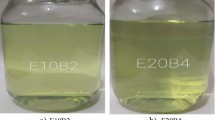Abstract
In the present work, exergy terms, irreversibilities, and the amounts of emissions in a two-stroke engine with alcoholic fuel additive have been investigated experimentally. The applied alcoholic additive is Ethanol which is combined with gasoline in different percentages of 5, 10, and 15 %. The experiments have been done for 2,500, 3,000, 3,500, and 4,500 (rpm). The results show that in most test cases where alcoholic fuel is used, the combustion internal irreversibility increases, which is due to the increase in temperature difference between burned combustion products and unburned mixture that occurs as a result of the rapid evaporation of the alcohol fuel additives. This is an important reason for second law efficiency reduction. But for the case of little additive percentage (5 %), it has a reverse effect which can be assumed as an advantage. The most outstanding result of using ethanol additive is that the production of pollutants such as HC, CO2, CO, and NO x has been significantly reduced in all test cases.

Similar content being viewed by others
References
Rakopoulos C.D., Giakoumis E.G.: Second law analyses applied to internal combustion engines operation. Prog. Energy Combust. Sci. 32, 2–47 (2006)
Caton, J.A.: A review of investigations using the second law of thermodynamics to study internal-combustion engines, SAE paper no. 2000-01-1081. Society of Automotive Engineers Inc.,Warrendale (2000)
Rakopoulos C.D., Giakoumis EG.: Speed and load effects on the availability balances and irreversibilities production in a multicylinder turbocharged diesel engine. Appl. Therm. Eng. 17, 299–313 (1997)
Sato, K.; Ukawa, H.; Nakano, M.: Effective energy utilization and emission reduction of the exhaust gas in a two-stroke cycle engine, SAE paper no. 911848. Society of Automotive Engineers Inc., Warrendale (1991)
Ghazikhani, M.; Feyz, M.E.; Joharchi, A.: Experimental investigation of the Exhaust Gas Recirculation effects on irreversibility and Brake Specific Fuel Consumption of indirect injection diesel engines. Appl. Therm. Eng. 30, 1711–1718 (2010)
Alasfour FN.: Butanol—a single-cylinder engine study: availability analysis. Appl. Therm. Eng. 17, 537–49 (1997)
Demirbas, A.: A realistic fuel alternative for diesel engines. Springer, London (2008)
Michaelides, E.E.: Alternative Energy Sources. Springer, London (2012)
Eyidogan, M.; Ozsezen, A.N.; Canakci, M.; Turkcan, A.: Impact of alcohol–gasoline fuel blends on the performance and combustion characteristics of an SI engine. Fuel 89, 2713–2720 (2010)
Li, X.; Qiao, X.; Zhang, L.; Fang, J.; Huang, Z.; Xia, H.: Combustion and emission characteristics of a two-stroke diesel engine operating on alcohol. Renew. Energy 30, 2075–2084 (2005)
Can, O.; Celikten, I.; Usta, N.: Effects of ethanol addition on performance and emissions of a turbocharged indirect injection diesel engine running at different injection pressures. Energy Convers. Manag. 45, 2429–2440 (2004)
Yang, H.H.; Liu, T.C.; Chang, C.F.; Lee, E.: Effects of ethanol-blended gasoline on emissions of regulated air pollutants and carbonyls from motorcycles. Appl. Energy 89, 281–286 (2012)
Lei, J.; Shen, L.; Bi, Y.; Chen, H.: A novel emulsifier for ethanol–diesel blends and its effect on performance and emissions of diesel engine. Fuel 93, 305–311 (2012)
Karavalakis, G.; Durbin, T.D.; Shrivastava, M.; Zheng, Zh.; Villela, M.; Jung, H.: Impacts of ethanol fuel level on emissions of regulated and unregulated pollutants from a fleet of gasoline light-duty vehicles. Fuel 93, 549–558 (2012)
Wark, K.: Advanced thermodynamics for engineering. McGraw-Hill Inc., New York (1995)
Rosen M.A.: Clarifying thermodynamic efficiencies and losses via exergy.Exergy, an Int. J. 2, 3–5 (2002)
Rodriguez, L.: Calculation of available-energy quantities. In: Gaggioli, R.A. (ed.): Thermodynamics: Second Lawanalysis, pp. 39–59. American Chemical Society Symposium, Washington, DC (1980)
Stepanov V.S.: Chemical energies and exergies of fuels. Energy 20, 235–242 (1995)
Heywood, J.B.; Sher, E.: The Two-Stroke Cycle Engine. Taylor & Francis, Philadelphia (1999)
Author information
Authors and Affiliations
Corresponding author
Rights and permissions
About this article
Cite this article
Ghazikhani, M., Hatami, M. & Safari, B. The Effect of Alcoholic Fuel Additives on Exergy Parameters and Emissions in a Two Stroke Gasoline Engine. Arab J Sci Eng 39, 2117–2125 (2014). https://doi.org/10.1007/s13369-013-0738-3
Received:
Accepted:
Published:
Issue Date:
DOI: https://doi.org/10.1007/s13369-013-0738-3




